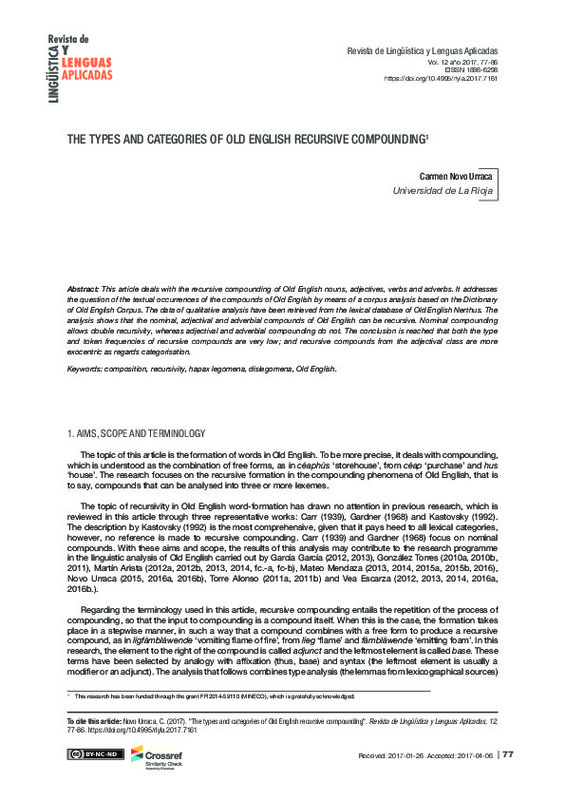BAAYEN, H., & LIEBER, R. (1991). Productivity and English derivation: a corpus-based study. Linguistics, 29(5). doi:10.1515/ling.1991.29.5.801
Bauer, L. (2008). A Glossary of Morphology. Edimburgh: Edimburgh University Press.
Bosworth, J. and Toller, T. N. 1973 (1898). An Anglo-Saxon Dictionary. Oxford: Oxford University Press.
[+]
BAAYEN, H., & LIEBER, R. (1991). Productivity and English derivation: a corpus-based study. Linguistics, 29(5). doi:10.1515/ling.1991.29.5.801
Bauer, L. (2008). A Glossary of Morphology. Edimburgh: Edimburgh University Press.
Bosworth, J. and Toller, T. N. 1973 (1898). An Anglo-Saxon Dictionary. Oxford: Oxford University Press.
Brinton, L. J., & Traugott, E. C. (2005). Lexicalization and Language Change. doi:10.1017/cbo9780511615962
Campbell, A. (1972). An Anglo-Saxon Dictionary: Enlarged addenda and corrigenda. Oxford: Clarendon Press.
Carr, C.T. (1939). Nominal Compounds in Germanic. St. Andrews: St. Andrews University Publication.
García García, L. (2012). Morphological Causatives in Old English: the Quest for a Vanishing Formation1. Transactions of the Philological Society, 110(1), 122-148. doi:10.1111/j.1467-968x.2012.01287.x
García García, L. (2013). "Lexicalization and morphological simplification in Old English jan-causatives: some open questions". Sprachwissenschaft, 38/2: 245-264.
González Torres, E. (2010a). "The Continuum Inflection-Derivation and the Old English suffixes -a, -e, -o, -u". Atlantis, 32/1: 103-122.
González Torres, E. (2010b). "The bases of derivation of Old English affixed nouns: status and category". Studia Anglica Posnaniensia, 46/2: 21-43.
González Torres, E. (2011). "Morphological complexity, recursiveness and templates in the formation of Old English nouns". Estudios Ingleses de la Universidad Complutense, 19: 45-70.
Kastovsky, D. (s. f.). SEMANTICS AND VOCABULARY. The Cambridge History of the English Language, 290-408. doi:10.1017/chol9780521264747.006
Martín Arista, J. (2012a). "Lexical database, derivational map and 3D representation". RESLA-Revista Espa-ola de Lingüística Aplicada, Extra 1: 119-144.
Arista, J. M. (2012). The Old English Prefixge-: A Panchronic Reappraisal. Australian Journal of Linguistics, 32(4), 411-433. doi:10.1080/07268602.2012.744264
Arista, J. M. (2013). Recursivity, Derivational Depth and the Search for Old English Lexical Primes. Studia Neophilologica, 85(1), 1-21. doi:10.1080/00393274.2013.771829
Martín Arista, J. (2014). "Noun layers in Old English. Asymmetry and mismatches in lexical derivation". Nordic Journal of English Studies, 13/3: 160-187.
Martín Arista, J. "El paradigma derivativo del inglés antiguo". Onomazeín. Forthcoming-a.
Martín Arista, J. "The Semantic Poles of Old English. Towards the 3D Representation of Complex Polysemy". Digital Scholarship in the Humanities. Forthcoming-b.
Martín Arista, J., & Cortés Rodriguez, F. J. (2014). From directionals to telics. Theory and Practice in Functional-Cognitive Space, 229-250. doi:10.1075/sfsl.68.10mar
Mateo Mendaza, R. (2013). The Old English Exponent for the Semantic Prime TOUCH. Descriptive and Methodological Questions. Australian Journal of Linguistics, 33(4), 449-466. doi:10.1080/07268602.2013.857574
Mateo Mendaza, R. (2015a). "Matching productivity indexes and diachronic evolution. The Old English affixes ful-, -isc, -cund and -ful". Canadian Journal of Linguistics, 60/1: 1-24.
Mateo Mendaza, R. (2015b). "The search for Old English semantic primes: the case of HAPPEN". Nordic Journal of English Studies, 15: 71-99.
Mateo Mendaza, R. (2016). The Old English Exponent for the Semantic Prime MOVE*. Australian Journal of Linguistics, 36(4), 542-559. doi:10.1080/07268602.2016.1169976
Novo Urraca, C. (2016). Old English Suffixation: Content and Transposition. English Studies, 97(6), 638-655. doi:10.1080/0013838x.2016.1183955
Novo Urraca, C. (2016). Morphological Relatedness and the Typology of Adjectival Formations in Old English. Studia Neophilologica, 88(1), 43-55. doi:10.1080/00393274.2016.1150788
Plag, I. (1999). Morphological Productivity. doi:10.1515/9783110802863
Sweet, H. 1976 (1896). The student's Dictionary of Anglo-Saxon. Cambridge: Cambridge University Press.
Toller, T. N. (1921). An Anglo-Saxon Dictionary: Supplement. Oxford: Clarendon Press.
Torre Alonso, R. (2011a). "The Morphological Structure of Old English Complex Nouns". Atlantis, 33/1: 127-146.
Torre Alonso, R. (2011b). "Affix Combination in Old English Noun Formation: Distribution and Constraints". RESLARevista Espa-ola de Linguística Aplicada, 24: 257-278.
Vea Escarza, R. (2012). Structural and Functional Aspects of Morphological Recursivity. NOWELE, 64-65, 155-179. doi:10.1075/nowele.64-65.09esc
Vea Escarza, R. (2013). OLD ENGLISH ADJECTIVAL AFFIXATION: STRUCTURE AND FUNCTION. Studia Anglica Posnaniensia, 48(2-3), 5-25. doi:10.2478/stap-2013-0005
Vea Escarza, R. (2014). Split and unified functions in the formation of old English nouns and adjectives. Revista de Lingüística y Lenguas Aplicadas, 9(1), 106. doi:10.4995/rlyla.2014.2086
Vea Escarza, R. (2015). Recursivity and Inheritance in the Formation of Old English Nouns and Adjectives. Studia Neophilologica, 88(1), 1-23. doi:10.1080/00393274.2015.1049830
Vea Escarza, R. (2016b). "Old English affixation. A structural-functional analysis". Nordic Journal of English Studies, 15/1: 101-119.
[-]








